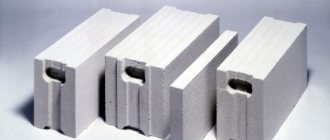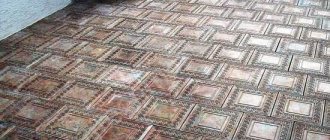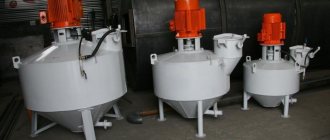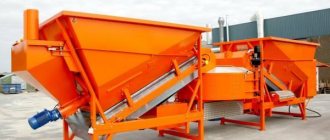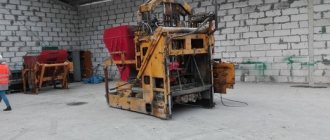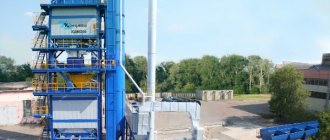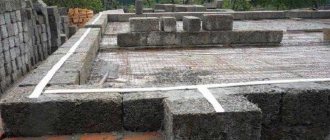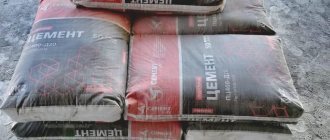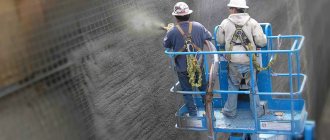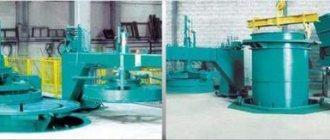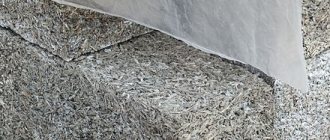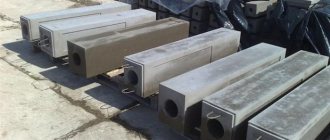Pros and cons of the material
If you plan to build from wood concrete, take into account its advantages and disadvantages. This allows you to determine whether the units are suitable for use in a given environment. Positive traits:
- versatility: the material can be used in the construction of various structures (walls, partitions, pouring slabs);
- due to its low density, wood concrete can be easily processed, it can be cut without significant effort, which makes it possible to adjust products to the required dimensions;
- low cost of blocks, this is due to the fact that the price of the necessary materials (cement and wood waste) is low;
- after hardening, the workpieces acquire sufficient strength, due to which various finishing coatings are firmly held on their surface, and there is no need to use a reinforcing mesh;
- the surface of the blocks is rough, this is the main factor contributing to increased adhesion of the finishing material;
- blocks reduce heat loss, thereby reducing the need for thermal insulation material;
- the products do not burn, despite the presence of wood in the structure, the sawdust is processed, which eliminates the possibility of fire;
- insects do not undermine the material, which is due to the presence of additives and cement, wood chips are not susceptible to negative effects, since they are mixed with cement mortar;
- buildings last a long time.
There are few disadvantages of such products. First of all, note exposure to moisture. Wood, although mixed with cement, has a tendency to absorb water. As a result, the products lose their properties. If the block absorbs too much liquid, it may collapse. In this case, the strength of the arbolite structure decreases.
In addition, the susceptibility of the material to rodents is noted. Despite the presence of cement, the blocks do not withstand contact with small animals. This drawback can be eliminated using an OSB board. Alternative options: installing a mesh; pouring with cement mortar, the layer thickness is small and the height is up to 50 cm.
Equipment
In general, the following equipment is required for the production of wood concrete blocks:
- Bunkers (containers) for storing and finishing chips;
- Bunkers (containers) for cement;
- Containers for chemical reagents;
- Equipment for mixing, if the bins do not have the ability to mix the mass;
- Water containers;
- Wood chipper or crusher;
- Block molds;
- Drying chambers (for industries with industrial production volumes).
The power of chippers and other machines for preparing raw materials (chips, hammer crushers, etc.) is selected based on the planned volumes of products.
Specifications
Wood concrete is divided into grades: 5, 10, 15, 25, 35, 50. Grades are the so-called indicator of the compressive strength of a building material. For example, an M15 block will withstand an average of 15 kg per square centimeter of surface. The blocks also differ in density. Taking into account the difference in this parameter, products are divided into structural and thermal insulation. The density in the first case is 500-850 kg/cm³.
Thermal insulation products perform the function of insulation; they have a low density (up to 500 kg/cm³), which makes them less durable, so they are not suitable for use as load-bearing structures. In accordance with this parameter, denser wood concrete blocks are used for the construction of 2- and 3-story buildings.
Product specifications:
- environmental friendliness, wood concrete contains up to 90% wood waste;
- resistance to deformation loads: bending strength - up to 1 MPa, compressive strength - up to 3.5 MPa;
- products are plastic, which allows them to withstand temperature changes while maintaining their shape;
- thermal conductivity is the lowest when compared with other insulation materials: up to 0.17 W/m*C;
- the elasticity index varies significantly: from 250 to 2300 MPa;
- the wood concrete structure can withstand up to 50 freezing/defrosting cycles, which ensures a long service life;
- moisture absorption - up to 85%;
- material shrinkage - up to 0.5%;
- sound absorption rate - up to 0.6 with sound with a frequency of 2000 Hz.
Performance characteristics
As you can see, the characteristics of the arboblock are quite good. The advantages also include light weight, large size and good ability to absorb sounds. A very big plus is that the blocks are easy to cut and can be easily given the desired shape. Another positive point is that wood concrete holds nails and screws well. There are no problems on this side either.
- Shrinkage - 0.5-0.6%. This parameter shows how much the geometric dimensions of the wall will change under load. Wood concrete has one of the lowest rates.
- Water absorption 40-85%. This figure is very large. If you put an arbolite block in water, it can absorb a lot of water. For the developer, this means that care must be taken to ensure good waterproofing between the foundation and the first row of blocks. An arbolite house also needs exterior finishing that will protect the material from moisture. It's not all that scary. It is much more important that the hygroscopicity of wood concrete is low (the ability to accumulate vaporous moisture). Even with very humid air, it does not become damp, but allows vapor to pass through itself, regulating the humidity in the room.
- Fire resistance - class G1. Arbolite refers to materials that do not support combustion. This is their undoubted advantage.
If we talk about technical characteristics, then there is essentially one serious disadvantage - high water absorption. There is one more drawback, but it is from the field of operation. Mice love arbolite very much. The material is natural and warm. The problem can be solved by making a high base - no lower than 50 cm.
Description of the enterprise
To carry out production activities, you must register an individual entrepreneur. It would be rational to choose a simplified taxation system, which amounts to 6% of gross income. As soon as employees are hired, you should register as an employer with the Social Insurance Fund and the Pension Fund of the Russian Federation, paying monthly insurance premiums for employees.
To produce wood concrete with a volume of 500 m3 monthly, you need to rent a room with an area of 250 m2 or more.
If a drying chamber , the curing time of wood concrete blocks can be reduced to several hours.
The premises will be operated as follows.
- The production area will occupy 50 m2.
- 100 m2 – drying and holding area.
- 100 m2 – storage of finished arbolite blocks.
An enterprise can work in one shift, 8 hours a day, with two days off (that is, 5 days a week).
To carry out production, you will need 4 general workers, 1 accountant and 1 sales and supply manager.
General workers can work in shifts , replacing each other in the format of two days of work, two days of rest.
Composition of arbolite blocks
The production technology of wood concrete blocks involves the use of the following types of materials:
- coniferous wood chips. Its production is carried out on the territory of a specialized enterprise where the wood concrete block is manufactured;
- mineralizer It is created on the basis of aluminum sulfate. The component does not emit harmful substances and is popular in the medical and food fields. Purification of industrial and domestic drinking water cannot be done without it;
- Portland cement. Product brand – M500. Used as a binder between wood chips and aluminum sulfate.
Organic Ingredients
Several types of material are used in the form of wood filler. Not every shaving is suitable as a raw material - the material should not be confused with sawdust concrete. The new GOST clearly regulates the size and geometry of fractions added to wood concrete.
- Chips - they are obtained by crushing non-commercial wood - slabs, knots, tops and the like. To produce wood concrete, wood chips are used 15–20 mm long – not exceeding 40 mm, 10 mm wide and 2–3 mm thick. In industrial conditions, crushing is performed by special installations. Practical studies claim that in order to achieve better quality in manufacturing, crushed wood chips for wood concrete should have a needle-like shape and be smaller in size: length up to 25 mm, width - 5-10 mm, thickness 3-5 mm. The fact is that wood absorbs moisture differently along and against the grain, and the above dimensions equalize this difference.
Not every tree is suitable for wood chips: you can use spruce, pine, aspen, birch, beech, but larch is undesirable. Before use, wood material must be treated with antiseptic compounds to prevent the development of mold or fungi.
- Crushed bark and pine needles can also be used. However, their share is smaller: bark should be no more than 10% of the product’s weight, and pine needles should be no more than 5%.
- The raw materials can be rice straw, flax and hemp seeds , as well as cotton stalks. The materials are crushed: length should not exceed 40 mm, width – 2–5 mm. Tow and tow, if they appear in the filler, do not exceed 5% of the mass. GOST 19222-84 regulates the sizes of fractions that are obtained by grinding one or another raw material. And although deviations in the proportion of ingredients are allowed, it is impossible to deviate from raw material standards.
Flax contains a large amount of sugars, and the latter, reacting with cement, destroy it. Before burning, the flax is soaked in lime milk for 1–2 days, or kept in air for 3–4 months.
Inorganic components
The binders in wood concrete, which is what wood concrete is called, are the following substances:
- Portland cement is a traditional material and the most popular;
- Portland cement with additional mineral components - this usually increases the frost resistance of the blocks;
- sulfate-resistant cement, with the exception of pozzolanic cement, provides resistance to chemically aggressive substances.
According to GOST requirements, only material of the appropriate grade can be used:
- no less than 300 for heat-insulating wood concrete;
- no less than 400 for structural.
Now let’s talk about the proportions of chemical additives in the wood concrete composition.
Chemical additives
The total amount of additional ingredients can reach 2–4% of the weight of cement. Most of them increase the strength of wood concrete: the substances interact with the sugars present in wood and form compounds that are harmless to cement.
The specific amount of ingredients is determined by the brand of wood concrete. For example, grade 30 wood concrete may include:
- calcium chloride and aluminum sulfate in a 1:1 ratio - no more than 4% by weight of cement;
- calcium chloride and sodium sulfate in a 1:1 ratio - no more than 4%;
- aluminum chloride and aluminum sulfate in a 1:1 ratio - no more than 2%;
- calcium chloride and aluminum chloride in a 1:1 ratio - no more than 2%.
Liquid glass - sodium and potassium silicates - can also be used for the same purposes.
Water
GOST regulates the degree of purity of water, but in practice any kind is used - central water supply, wells, boreholes. For the quality of wood concrete, the water temperature is fundamental. It is added to the composition along with additional ingredients.
In order for the rate of cement hydration to be sufficient, you need water with a temperature of at least +15 C. Already at +7–+8 C, the setting rate of cement drops noticeably.
Next, we will consider the recipe, the composition of the proportion of the mixture per cube (1m3) of wood concrete with your own hands.
Arbolite blocks - description of the material
Arbolite is one of the types of lightweight concrete, for the creation of which organic filler in the form of wood chips is used. Cement increases the strength of the material structure. Additionally, manufacturers include water and chemical additives.
Depending on its purpose, wood concrete is divided into two categories - heat-insulating and structural.
The determining factor is the density of the material. When constructing load-bearing parts of a building, the use of blocks with a density of no more than 500 kilograms per cubic meter is not permitted. They are suitable for arranging thermal insulation of external walls in buildings with the presence of additional load-bearing elements that take on the main load from the floors and roof.
The difference between arbolite-based blocks is their density, varying from 550 to 700 kilograms per cubic meter. Wood concrete houses, the designs of which involve the use of materials with a density of 850 kilograms per cubic meter, are characterized by high strength, but poorer thermal insulation properties. As the density increases, the thermal insulation value decreases. Density measurement is carried out after obtaining a stable mass after releasing excess moisture.
GOST
The composition of wood concrete is regulated by GOST 19222-84. The standard allows the composition of the mixture to be selected in laboratory conditions, but imposes strict requirements on the raw materials and the parameters of the final result. Depending on the compressive strength and thermal insulation performance, there are 2 types of wood concrete:
- thermal insulation, that is, designed for wall insulation;
- structural – construction of self-supporting walls is allowed.
The indicators of these materials are different.
Type of wood concrete Class by compressive strength Brand by strength under axial compression Average density, kg/cub. m.
| On chopped wood | On a fire of flax or cotton stalks | On a hemp fire | On rice straw | |||
| Thermal insulation | B0.35 | M5 | 400–500 | 400–450 | 400–450 | 500 |
| B0.75 | M10 | 450–500 | 450–500 | 450–500 | ||
| B1.0 | M15 | 500 | 500 | 500 | ||
| Structural | B1.5 | – | 500–650 | 500–650 | 550–650 | 600–700 |
| B2.0 | M25 | 500–700 | 600–700 | 600–700 | – | |
| B2.5 | M35 | 600–750 | 700–800 | – | – | |
| B3.5 | M50 | 700–850 | – | – | – |
Since the operating conditions of wood concrete products can be very different, they may be subject to additional requirements regulated by GOST 4.212-80.
The grades of wood concrete are named according to GOST 25192-82. The structure of the material may also be indicated.
Dimensional deviations in products
GOST regulates possible dimensional deviations in products:
- in length, with a total block length of up to 3.0 m - no more than 5 mm;
- for product lengths from 3 to 6 m – 7 mm;
- deviations in height and thickness can only be within 5 mm;
- the error in the dimensions of protrusions, recesses, shelves, ribs, and so on does not exceed 5 mm.
It is allowed to reinforce wood concrete products with meshes and steel rods, regulated by the relevant GOST.
Since the material is not highly moisture resistant, the outer surface of the products is covered with a layer of decorative concrete or other material with mineral fillers. The inner layer may be missing. Finishing with cement or cement-lime mortar is allowed.
Checking the crossbow mixture
According to GOST, the crossbow mixture is checked at least 2 times per shift:
- estimate the density indicator;
- workability;
- level of delamination;
- assessment of intergranular voids.
To test for strength, a series of laboratory tests are carried out, for the mixture after 7 days of hardening, for the mixture after 28 days, and for the mixture that was tested both after 7 days and after 28.
- Frost resistance is assessed for finishing and load-bearing layers,
- Thermal conductivity is measured using samples of the mixture,
- Humidity is calculated on samples from finished products.
Only if the mixture passes the tests proposed by GOST can it be fully considered working and accepted for production.
Wood concrete is an example of a successful combination of organic filler and inorganic binder. And as with all types of concrete, the composition largely determines the quality of the final product.
You will learn how to select the composition of wood concrete and mix the ingredients for building a garage in the video below:
Production: raw materials, technology, main stages
A good block is, first of all, high-quality components. We use raw materials that comply with GOST standards and ensure that all enterprises in the network comply with this requirement.
- Coniferous wood chips contain the least amount of sugars, which slow down the setting of the mixture.
- Cement grade no lower than M500 provides the necessary strength.
- A mineralizer is needed to neutralize these sugars. Our manufacturers use aluminum sulfate as the most effective and safe among analogues.
- Water should have a hardness of no more than 7 mEq/l. If the indicator is higher, it will slow down the setting processes and the final strength will not be sufficient.
Violation of technology leads to loss of strength and/or geometry of the block, so strict adherence to it is one of the conditions for cooperation with Russian Arbolit. There is nothing complicated in the process, the main thing is a conscientious attitude.
- All wood chips must have the same moisture content - for this they are soaked; in this case, you can immediately use not water, but a mineralizer solution.
- Wood chips and cement are placed in a special mixer.
- The semi-dry, non-flowing mixture is stirred for several minutes.
- Through the side gate or doors (depending on the selected equipment line), the wood concrete enters the mold cells on the vibrating table. The mixture is leveled by hand and covered with contact plates.
- The pressure plates are lowered, pressing the block with the desired pressure.
- The operator locks the molds with special pins - this is called sixth face sealing technology.
- The filled molds are taken to the curing area, stacked with timber, and left for at least 24 hours. Instant formwork is prohibited - this technology harms both the strength and geometry of the product.
What the production process looks like:
Equipment for the production of wood concrete blocks: technical equipment of the enterprise
Equipment is purchased depending on what technology was chosen for the production of wood concrete blocks, based on the raw materials used and the desired output volumes:
Equipment Purpose
| Machines DU-2, RRM-5, MP-500 and analogues | For cutting wood. Hammer mills, wood chippers, and DM-1 type units crush raw materials more thoroughly. |
| Vibrating table | Necessary for cleaning wood chips from bark, pieces of dirt, and earth. |
| Paddle or cyclic forced action mixers | The mixture for arbolite blocks is prepared in them. |
| Concrete distributors / lifting stations | For transporting the finished solution to the molds. |
| Brick presses Condor, Rifey, etc. | For compacting blocks. |
| Thermal cameras | With their help, complete hardening of wood concrete products is achieved. They can be equipped with IR emitters, heating elements and allow you to set the level of humidity and temperature required for the production of blocks. |
| Forms | They are selected in accordance with the dimensions of the wood concrete materials that you are going to produce. You don’t have to purchase them; you can make them yourself from boards 2 cm thick. After they are knocked into certain sized shapes, the inside is covered with a layer of plywood, then with a layer of linoleum/film. |
New equipment for small businesses
If you are making blocks at home, you will need the following kit:
- serving table;
- vibrating table;
- chip catcher;
- detachable metal forms and inserts attached to it;
- shock-shaking table;
- dispenser of crushed wood, cement;
- vibroforming machine;
- installation that lifts forms;
- pallets;
- tray for receiving wood concrete mixture.
With such a list of units, you can achieve good production volumes in a month (about 300 sq. m). To place the equipment, you need 500 sq. m area. In this case, only 15-40 kW/h of electricity is consumed.
In the case of large-scale industrial production, it is better to buy a highly automated line that produces wood concrete blocks and includes all the necessary mechanisms.
Such equipment for the production of wood concrete blocks can be in different variations and configurations.
The standard package includes:
- concrete mixer,
- chipper,
- pallets,
- drying chamber
- Press forms,
- vibropress.
Production on powerful installations allows the production of up to 800 blocks in one 8-hour shift. The cost of these reaches 1.5 million rubles.
Industrial equipment can be purchased from the following companies:
- "Arbolit" (https://www.arbolit.com/Zapusk-proizvodstva-arbolita).
The company is ready to offer lines for the production of wood-cement blocks: Liga-Avtomat, Liga-7, Liga-8U, etc. Arbolit provides services for commissioning, training of workers, production of a trial batch.
The units are characterized by ease of operation and ease of use, compactness, low payback period, full use of wood waste, and a small number of maintenance personnel.
- “Russian wood concrete” (https://ruarbolit.ru/oborudovanije).
Since 2006, the company has been designing and selling ready-made lines for the production of wood concrete products.
The company's equipment is characterized by moderate price, reliability, but low productivity. The kit may not include a woodchip chopper. The units are small in size, so they can be easily located in workshops with low ceilings.
- OKB Sfera LLC.
The plant produces complexes for the production of wood concrete panels and blocks, which are highly mobile and productive, easy to maintain.
Production stages and pitfalls
The wood chippers available on the market differ in:
- Operating principle.
- Power indicators.
Some units belong to the household group and are suitable for simple work on processing branches and waste. Using such a machine, you will need to purchase additional equipment for cutting raw materials.
To avoid unnecessary costs, it is better to immediately buy a powerful device with a wide neck and cutting elements. The optimal solution is a rotary knife chipper. The cost of such an installation is 500 thousand rubles, but it quickly pays for itself.
For private production, a shredder machine is suitable, cutting wood layers into noodles. Using the device, you can reduce the grade of cement to M400.
The working area where the wood chipper will be installed must be connected to an uninterrupted power supply of 380 volts and be designed for a 10 kW motor. Sawdust or shavings must not be used for the production of wood concrete, with the exception of large shavings from a rounding machine.
The most affordable machine - PM200 - is suitable for home production of wood concrete blocks.
Optimal equipment for production
The production process involves the use of the following units:
- Disc chip cutter. You can use the DS31 model worth 199 thousand rubles as it. It has compact dimensions, ergonomics and accessibility, but depends on the power supply.
- Hammer chopper (DS31). The cost of the device is 273 thousand rubles. The advantages include increased power, and the disadvantages include the need to use special equipment to transport the final raw materials.
- Rotary chopper (BMP). Sold at a price of up to 230 thousand rubles. Characterized by combined chip production and increased productivity. The disadvantages of the model are the limited neck size, which is why the raw materials need to be adjusted to size.
- Mixer (BMP). Cost - 400 thousand rubles. It has a large volume for commercial chip production, but is not suitable for simple tasks in private construction.
- Liquid reservoirs. As such, you can use Irplast models, which are available at prices ranging from 7 to 10 thousand rubles. Capacity - 500 l.
The units used must be powerful, efficient and ergonomic.
Production plan
This business requires the purchase of an appropriate machine. The main criterion for its selection is the planned sales volume and the amount of starting capital.
On the market you can find machines made by both domestic and foreign manufacturers. The latter, of course, are more expensive, but a novice entrepreneur, strapped for funds, should hardly pursue high-tech equipment.
The standard automated line includes the following machines and devices:
- concrete mixer;
- chipper;
- Press forms;
- vibropress;
- drying chamber;
- pallets.
The cost of equipment is greatly influenced by the degree of automation and the equipment of the line. The price of a high-performance machine, whose capacity reaches 1000 m3/month, is approximately 1.5 million rubles . But purchasing a manual machine without a drying chamber will cause a much smaller blow to the budget - about 300 thousand rubles .
In this case, you need to evaluate all the positive and negative aspects, since the presence of drying can significantly speed up the technological process, which will allow you to quickly recoup the investment. The average power of a manual machine varies from 300 to 400 m3/month.
Purchasing a wood chipper with which you can prepare raw materials is advisable in the following cases:
- the cost of wood raw materials in a particular region is too high;
- the material is very difficult to find.
The supply of finished sawdust can be negotiated with a nearby sawmill, where this raw material is a production waste.
It is advisable to locate the future workshop on the territory of a small regional center, since cheap labor can be found here. A good option is near a pine forest terrace (this will provide production with regular free sand) or a sand quarry and a working sawmill. The presence of a convenient transport interchange cannot be ignored, as this makes it easy to remove finished blocks and deliver cement and lime.
If a microdistrict or private houses have begun to be built nearby, then there is no doubt about the success of the chosen type of activity.
Is the project planned for a long period of time? This means you should worry about the availability of production premises. Automated line, delivery, storage of raw materials and storage of the finished product - all this influences the ideology of building a business.
The production facility must meet the following basic requirements: a height of at least 5-6 meters and dimensions of 25*10 meters . To maintain optimal temperatures in winter (15-20 degrees), ensuring uniform drying of the blocks, mineral wool or polystyrene foam can be used.
The glazing of the room should occupy no more than 5-7% of the total wall area. It is imperative to place two lock chambers (one is needed for receiving raw materials, and the other for shipping finished products) and one entrance/exit for personnel. Production can be located in an easily assembled hangar, an old brick barn or a cowshed, the main thing is that all the above requirements are met.
The premises must have a protected (grounded) 380V power line that can handle three-phase electric motors, even if they are running simultaneously.
Increased fire hazard (drying, dry wood chips or sawdust with straw) requires that the room corresponds to fire safety category A or B. That is, special anti-fire sensors and automatic fire extinguishing must be placed.
You can clearly see the manufacturing process in the following video:
Technology for the production of wood concrete blocks: process features
The recipe for raw materials is not easy to determine. This must be done by an experienced technologist. Without his help, using an experimental method, you can choose the wrong dosage of components and disrupt the entire production technology.
The raw material mass was developed in the ratio shown in the picture back in the Soviet Union. It is more economical than others, because allows the use in production of secondary filler, which is obtained from particle boards.
Such a filler does not need to be pre-treated, so less energy resources are spent, the production of wood concrete products becomes less labor-intensive, the environment improves due to waste disposal, and the range of building materials is expanded.
Arbolite blocks can be made in 2 ways, which are worth considering in detail.
Method number 1. Tamping by hand on the floor - most economical
To produce using this method, buy a forced-type mixer and a tank where chemical additives will need to be diluted.
In addition, you will need containers with a measuring ruler for loading wood chips and cement into the mixer, and steel forms that serve as a place for compacting the wood concrete mixture. Wood concrete is transported to the forms using a trolley.
The surface of the floor on which the production stage, such as the formation of blocks, takes place must be flat, plywood or concrete. In addition, the company is provided with pallets designed for stacking finished wood concrete blocks.
Method number 2. On a machine, vibration with a weight is more rational for large production volumes.
These machines are difficult to find on the market, but you can negotiate with an industrial enterprise to produce the equipment according to your order.
- Dirt-free chips corresponding in size and composition to Gosstandart 19222-84 are immersed in the mixer.
- Then a solution is made from chemical additives and water.
- When this procedure is completed, the mixer is started. The resulting solution is added to it, and the wood chips are stirred for 20 seconds.
- Only after this can you start adding cement. This is done in such a way that the cement mixture covers the entire area of the crushed wood.
- The mass is mixed well for 3 minutes. Water is no longer poured into the mixer container, because... this action will lead to the production of wood concrete blocks of insufficient strength.
- The pallets are placed next to each other on the vibrating platform of the machine. One general form is placed on them, which must be fixed during the production of blocks for the machine.
- Afterwards, the wood concrete mixture is poured into it, and pressing occurs with a loss of 30% of the previous volume.
- The mixture is kept in the formwork for some time to harden, then the blocks are removed and left in a warm room for 10 days. It is allowed to stack blocks one on top of another in 3 rows.
Please note that sawdust cannot be used fresh! If you cut the raw material yourself, let it dry for about a month after chopping.
To apply more wood concrete products, another 7 days must pass. Transportation is carried out two weeks after the production of wood concrete blocks, if the weather is dry. In rainy, damp weather - after 20 days.
So, the production of wood concrete blocks can be described in 4 main stages:
In order for sawdust concrete to be of high quality, it is necessary to organize incoming control of incoming raw materials in production.
Recipe
There are several recipes for wood concrete mixtures, but they all boil down to getting rid of moisture and sugars as effectively as possible , and then preventing moisture from getting inside the wood chips (not to be confused with moisture inside the block).
A properly manufactured block does not have a dew point by definition, so it is considered as insulation and building material at the same time.
There is also a lot of discussion regarding the most common recipes
But few people think about the fact that the locations of possible production are different for everyone, and the climate is also different everywhere. In the Kirov region, for example, there is very high humidity, and in order to provide the required drying for the wood chips, you will have to try hard. The counter-argument will be the Orenburg region with low humidity.
You need to make sure that after drying, the wood chips do not pick up water when mixing the mixture and swell. This moment happens often, and manufacturers call it subsequent swelling of the block. In some places this coefficient is large, in others it is small.
Now directly about the recipe and chemical additives . Today, a group of four chemical substances has firmly established itself, which in various combinations are capable of developing their own recipe , based on the place of construction of the building and the place of production of the blocks (if it comes to commercial production).
Proportions
Like any building material, wood concrete is divided into strength classes. For the construction of load-bearing walls of houses, the required strength class is B 2.5.
The number and proportions of wood concrete components depending on the brand
The amount of necessary materials per cubic meter of wood concrete mortar is in the table (photo above).
Pressing technologies
All these components are mixed and blocks are formed from them. There are several technologies:
- simply by pressing: manually on the floor (great effort required);
- manual rammer on a vibrating table.
The easiest way to do this is by hand pressing. But it is difficult to control the density and strength of the resulting blocks in this way.
Manual molding of wood concrete blocks
Normal production conditions
For the normal process of cement hydration, a temperature of at least +12°C is required. There are no other conditions. The peculiarity of production is that after molding the block, at least 2-3 weeks must pass before it can be used. During this time, the cement will gain about 50-60% strength (depending on temperature) and you can already work with the blocks. That is, blocks must be made long before construction begins. If you consider that the wood chips must sit for at least 4 months before they are used, then you can start a year before construction.
This is how you can store wood concrete blocks made by yourself
Another practical point: if you are going to make wood concrete blocks with your own hands, in addition to a platform for mixing and storing components, you need a platform for settling the blocks. The place should be covered, protected from rain and sun. There should be no drafts either.
We are opening a business for the production of wood concrete. Equipment, raw materials and manufacturing technology.
Wood concrete is also popularly called wood brick. This is an inexpensive, and most importantly environmentally friendly material, which is used in low-rise construction or as insulation for load-bearing walls. It consists of wood chips or shavings, cement and water. And to organize the entire business of wood concrete production, you will need very little equipment that can be repaid within a year.
If we talk about the percentage of the composition of these blocks, then in most cases shavings occupy about 60% - 85%, and cement 15% - 40%, depending on the recipe.
Where to get raw materials?
This is probably one of the most frequently asked questions regarding this business idea. The main material from which these blocks are made is waste from wood production (sawdust, shavings). Often these raw materials can be purchased at a low price, or even obtained for free. Due to such savings, the cost of the unit produced is low, while profitability increases. The main thing is to sign an agreement with several woodworking enterprises in order to have a stable flow of the necessary raw materials for the wood concrete business.
Material advantages
In construction, wood concrete is positioned as a material for the construction of low-rise structures, with excellent technical performance. In addition, its price tag is lower than, say, the same gas block, which also plays an important role for many clients. Here are the main advantages you need to know about wood concrete.
1.) This material is environmentally friendly, which in turn attracts customers who care about the health of their family.
2.) Such blocks, with the correct manufacturing technology, are not subject to fungus and rotting, and it is also convenient to perform any necessary operations with them - cutting, grinding.
3.) High sound and thermal insulation characteristics.
4.) High fire resistance. From such material it is possible to build objects that have an increased fire safety rating.
5.) Due to its structure, which consists of pores, it ensures air convection in the room, as well as a normal level of humidity.
6.) Wood concrete is quite lightweight, and buildings built using it are quite durable.
7.) Good profitability, simple production process, and minimal cost.
This entire list of characteristics has made wood concrete popular in the building materials market.
Such blocks are used to build not only residential buildings, but also summer kitchens, utility rooms, garages, etc.
Another business option for the production of pellets. About materials, equipment, technology and business calculations.
Documentation
Before starting production, you need to register as an individual entrepreneur or as a legal entity. face. The second step will be the selection of a taxation system and the indication of OKVE for the activity.
From the permitting documentation, you will also need permission from the SES and fire supervision.
Since this type of activity involves the involvement of workers (4 general workers, an accountant, a sales manager), you will need to register them and pay monthly fees.
Don't forget to sign a lease or sale agreement for the premises.
Technology for the production of wood concrete blocks
It is worth immediately noting that wood concrete blocks also come in different brands, which, depending on the percentage in the composition of wood chips, are used for different purposes. For example, brands: M5, M10, M15 are used for insulating walls, and from brands: M25, M35 for the construction of load-bearing structures.
To start the technological process you will need the following raw materials:
- cement grade 400 or 500.
- wood chips and sawdust.
- chemical mixtures for wood processing.
- water.
For example, to produce 1 cubic meter. arbolite block brand M15 use the following recipe:
- wood chips - 240-300 kg.
- cement - 250-280 kg.
- chemical mixtures - 12 kg.
- water 350-400 l.
For the following brands, reduce the volume of chips and increase the percentage of cement composition.
The production process itself can be divided into several stages:
- loading wood waste into a cutting device. Aluminum sulfate or potassium chloride and other chemical additives are also added here for wood processing. The installation cuts waste to the required size.
- Then, in addition to wood chips, cement and water are added to the mixing plant (concrete mixer). At this stage we obtain a ready-made arblit mixture.
- the finished solution is poured into molds, and compacted using a manual tamper. If the budget allows, buy a vibrating table for this stage.
- after completion of the previous process, the blocks are removed from the mold and sent to the drying chamber for 2-3 days.
- completed blocks can be moved only after a week. And the material itself can be used for construction only after a month.
As you can see, the production of wood concrete as a business does not contain any complex technological solutions. The main thing here is to follow the recipe and the stages of compacting and drying the blocks as a whole.
Room
For a small workshop you will need to rent at least 200 sq.m. 50 sq.m. area, of which to allocate for the workshop, 75 sq.m. for a drying chamber and 75 sq.m. to warehouses for finished products.
The room must be ventilated and cold water must be supplied. A 380V power supply is required.
Don't forget about the fire safety system, as well as video surveillance and burglar alarms. This will reduce the risk of equipment loss, and you will definitely sleep better.
Find out how to start your own paving stone production. Selection of raw materials, equipment and manufacturing technology.
Equipment
A set of equipment can be purchased either in the format of a finished production line, or you can create it yourself. In addition, you can save money by buying used equipment and reduce the price tag on equipment by up to 40%. But you need to carefully look at the degree of wear of the machines and calculate the real benefits of such a step.
1.) Mixing station - $3750.
2.) Hand tampers - $500/set. Or a vibrating table – $700 per piece.
3.) Molds - $120 each. To start, you will need to purchase about 25 - 35 pieces. The approximate amount will be about $3600.
4.) Chamber for drying products – $8000.
5.) Chip cutting device - $4600.
6.) Pallets for finished products - $1000.
7.) A machine for transporting finished products on pallets (subject to sufficient funding). We will not include this item in the total costs.
The total amount is about $21,450.
The same drying chamber, which eats up the lion's share of the budget, at first you can not buy it and just use dry rooms with heating for this, and over time you can think about such professional equipment.
Sales markets
The best solution would be to establish wholesale sales of products. In this case, you will be able to work with large volumes.
Can be implemented on:
- wholesale and retail bases and stores of building materials;
- directly through sales managers with personal connections;
- through advertisements in the media.
But you shouldn’t completely abandon retail sales. After all, even a private client, when building a house, can purchase good batches of blocks, and even at a retail price. Therefore, here, most likely, you need to combine both. And the wood concrete sales manager will play a very important role in sales growth.
Business expenses
What is a business plan without calculating the main cost parts? Here it is worth highlighting that in the case of wood concrete, the starting capital is required to be very small, and at the same time it can always be adjusted by purchasing this or that equipment. We will analyze the purchase of a ready-made production line right away.
Basic costs:
- purchase and adjustment of equipment – $21,000
- renovation of the premises and supply of necessary communications – $80 per 1 sq.m.
- purchase of raw materials – $8000
- paperwork – $200
Monthly investments:
- rent for the premises – $9 – $12 per 1 sq.m.
- communal payments
- taxes – from $150
- salary – from $200 per employee
- transportation costs – $100
The monthly cost of running a business can be reduced by operating from your own premises, or by reducing the number of employees to make more efficient use of the overall workforce.
How much can you earn?
Let's assume that your production volume will be 450 cubic meters. wood concrete per month. So in the case of sales at a wholesale price, which averages $40/cub.m. then the amount of revenue will be $18,000 per month. With retail sales ($50/cubic meter) it will be $22,500.
From these amounts, you can subtract monthly expenses, as well as the cost of producing the unit. The net profit will be around $5,000 – $7,000.
The payback period for a business with such sales volumes will be about 9 – 14 months.
Conclusions. Making money from arbolite blocks is a completely feasible business idea for small-scale production, which can bring good income with a relatively small investment. It is only important to find markets and purchase good equipment to obtain high-quality blocks, and then you can scale the business.
Do you have experience in this market segment? We look forward to your feedback and recommendations.
How to make wood concrete with your own hands
After assessing the main operating points, the wood concrete production process can begin. It is important to consider for what purposes the material will be used - private or commercial. In the first case, it is not necessary to buy expensive units and equipment.
Equipment
The key unit for home production of wood concrete blocks is a wood chip cutter. You can build it yourself by ordering the main part from turners. In this case, costs will decrease by 4 times. The cutting elements should be installed at a minimum angle, and the neck for feeding chips should be secured vertically.
A homemade wood chip cutter consists of the following units:
- Car spring.
- Metal studs.
- 2 bearings per axle.
- Axis.
To make the last part, it is better to use a hexagon, having previously organized the seats for the bearings. There are a lot of training videos and instructions on the Internet for implementing such a project.
Creation of a hammer machine
At the next stage you will have to build a hammer machine. You need to make holes in 2 disks for the axles and secure a washer 10-20 mm wide. On one side of the axle, a thread should be cut for the nut. If you have a lathe, it is better to machine the shaft and remove the knife disk from it to create a rectangular protrusion for attaching the second disk.
If possible, it is necessary to organize 2 height differences for the discs, while the final shaft thickness should be at least 50 mm.
The finished shaft is mounted on bearings and a support. If the size of the outer casing is smaller than required, it will have to be replaced or remade. The outlet hole is sealed with a steel mesh with an optimal diameter.
Bins and forms
Industrial bins and forms are sold in standard sizes that correspond to the parameters of polystyrene concrete or foam concrete blocks. Wood concrete is characterized by dimensions of 20, 40 or 60 cm. Creating blanks with your own hands is problematic, so it is better to cut metal sheets with a grinder and prepare a typesetting mold.
Development of technology
The most difficult stage is developing the technology in order to determine all the intricacies of the equipment’s operation. It is better to divide the application of chemicals into several separate stages. To begin with, sodium chloride and aluminum sulfate are added, and the remaining additives are placed in the hopper before mixing.
Liquid glass is used later, when the wood chips are ready. The final solution is poured into molds, compacted and left for some time to harden. The setting process takes 2-3 days, after which the molds are dismantled and the blocks are placed to dry.
Raw materials and recipe
If we consider wood concrete from the point of view of concrete manufacturing technology, then it can be classified as “lightweight concrete”. But this material is not concrete in the classical sense, since there is no sand among the fillers.
In general, the composition of any concrete includes the following components:
- Sand;
- Binding material;
- Light or heavy filler.
In wood concrete, the filler is organic matter (wood chips, etc.), and the binding material is cement. These components have low mutual adhesion, so it is very important to maintain the block manufacturing technology and understand the interaction of the components of the working mixture: cement, wood chips and chemical reagents.
In general, the composition of wood concrete consists of the following components:
- Organics;
- Cement;
- Chemical reagents.
Chips obtained from raw wood have a shape that allows them to be placed randomly in the space of the block. Also, the amount of cement required to prepare the wood concrete mixture depends on the size and shape of the wood chips. Dry wood produces small, needle-shaped chips. This structure and shape of the chips significantly increases the amount of cement required to fasten the chip elements together. It is necessary to have needle-shaped chips in the solution, but in small quantities.
When preparing a working mixture for making wood concrete blocks, it is necessary to rid the wood chips as much as possible of moisture and sugar. If the blocks are made correctly, they will not have a dew point. Such blocks can be used both as a building material and as insulation at the same time.
The following can be used as an organic filler for the mixture:
- Wood chips (basically the chips that are obtained after milling across the wood grain);
- Chips of branches, twigs after grinding;
- Wood sawdust;
- Straw or hay;
- Stems of various plants, small branches or leaves in small quantities (up to 10% of the volume).
Since wood contains various polysaccharides and sugars, cement and wood have very little adhesion. Cement mortar is an alkaline medium, once in which polysaccharides and sugar become water-soluble and disrupt the chemical hardening reactions (more sugars - less cement hardens). The result is a loose cement stone that cannot bind wood filler into a single whole and has low strength.
In order to prevent the formation of loose cement stone, various hot aqueous solutions of chemical reagents are used to wash out various sugars from wood chips.
Such reagents are:
- Sodium silicate (closes pores and prevents moisture from entering the wood);
- Calcium chloride (destroys microorganisms in wood chips and enhances the anti-putrefactive properties of the mixture);
- Aluminum sulfate (breaks down sugar and reduces the time for the mixture to gain strength);
- Slaked lime (if necessary, can be used as a replacement for calcium chloride and aluminum sulfate).
Wood concrete is produced in two types - thermal insulation (strength grades M5, M10, M15) and structural (strength grades M25, M35, M50).
For one cubic meter of wood concrete it is necessary (depending on the recipe):
- Chemical reagents – from 6 to 10 kg;
- Cement – from 250 kg;
- Organics – from 250 kg.
The table shows the number of main components in various volumes per cubic meter of wood concrete of the corresponding brand.
| Wood concrete brand | Cement | Wood chips | ||||
| Bags (pcs.) | Buckets (pcs.) | Shovels (pcs.) | Bags (pcs.) | Buckets (pcs.) | Shovels (pcs.) | |
| M5 | 3 | 12 | 36 | 25 | 100 | 300 |
| M10 | 3,5 | 14 | 42 | 25 | 100 | 300 |
| M15 | 4 | 16 | 48 | 25 | 100 | 300 |
| M35 | 5 | 20 | 60 | 25 | 100 | 300 |
| M50 | 6 | 24 | 72 | 25 | 100 | 300 |
Application of blocks, panels, slabs
Heat-insulating wood concrete slabs are very effective when laid on floor slabs and floor beams, as they do not require specific installation requirements . It is enough to place them tightly together. It is perfectly acceptable to use grout to seal the joints.
From blocks, the proportionality of which is close to FBS blocks, long purlins of the walls of townhouses or the walls of buildings that structurally meet certain requirements are laid out:
- height from base;
- uniform arrangement of windows;
- lack of internal connections with other walls.
Blocks of standard sizes are used for construction according to individual projects:
- houses;
- baths;
- garages.
Many companies practice making blocks according to customer sizes . It is not recommended to build basement floors that directly border the ground.
Types of sales of arbolite blocks
All this creates conditions for demand for the type of material in question. And this, in turn, indicates the profitability of this type of business. To avoid problems with the sale of finished products, it is necessary to use two types of product sales. First, we need to arrange direct shipments from the manufacturer’s warehouse to the companies that use these blocks in construction. If this cannot be done, then you need to try to find a common language with wholesale trading enterprises that will be able to sell products in other regions.
